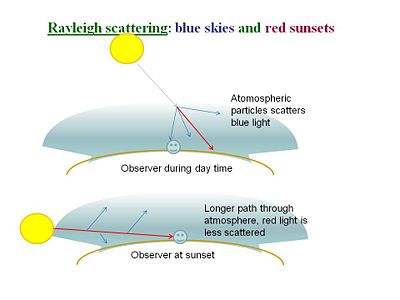Difference between revisions of "Dispersion and Scattering of Light"
Cmditradmin (talk | contribs) |
Cmditradmin (talk | contribs) |
||
| Line 8: | Line 8: | ||
Here is a light beam I<sub>0</sub> that is coming from the left towards a scattering center. | Here is a light beam I<sub>0</sub> that is coming from the left towards a scattering center. | ||
<math>\ | <math>\rightarrow{I_0} \circledast \rightarrow{\theta}\,\!</math> | ||
Revision as of 16:33, 11 May 2009
Return to Basics of Light Menu | Next Topic
Plane glass is an amorphous material with no crystalline structure. This prevents various refractive processes from occurring that would ruin its transparency. This is why optical fibers are made with amorphous materials. Light can be scattered in any inhomogeneous medium, that is, if there are fluctuations in the refractive index. Amorphous materials tend to be inhomogeneous.
Here is a light beam I0 that is coming from the left towards a scattering center.
<math>\rightarrow{I_0} \circledast \rightarrow{\theta}\,\!</math>
<math>I_s (\theta)\propto I_0 \; \frac{V^2} {\lambda^4} ( 1 + cos^2 \theta)\,\!</math>
The expression for Rayleigh scattering.
It is valid for small spherical scattering particles of volume V with a diameter less than 1/10 of λ of incident light
The scattering particles (scattering centers) can be as small as a single molecule
Scattering depends on the angle but it not an all or nothing relationship. The intensity of the beam going straight vs theta at 90 degrees there is just a factor of 2 difference because of the 1+cos2theta expression. Otherwise there would be much more effect from the angle.
Since Rayleigh scattering is proportional to <math>\frac{1}{\lambda^4}\,\!</math> scattering is larger for blue light than for red light. For a given angle of scattering the blue light will be scatter 16x as much as the red. This is the reason the sky is blue.
